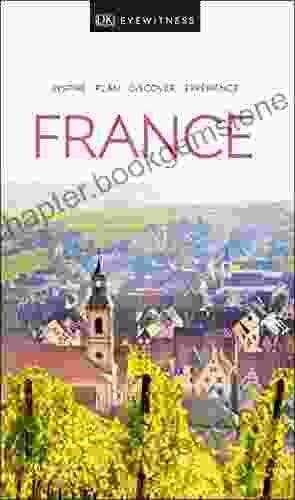The Geography of Wine: A Journey Through Terroir, Climate, and Vines

The world of wine is a symphony of flavors, aromas, and textures, a tapestry woven from the intricate interplay of nature and human ingenuity. At the heart of this tapestry lies the geography of wine, a captivating discipline that explores the profound influence of terroir, climate, and grape varieties on the character and quality of wines.
4.1 out of 5
| Language | : | English |
| File size | : | 1072 KB |
| Text-to-Speech | : | Enabled |
| Screen Reader | : | Supported |
| Enhanced typesetting | : | Enabled |
| Word Wise | : | Enabled |
| Print length | : | 308 pages |
Terroir: The Essence of Place
Terroir, a French term meaning "land," encapsulates the unique characteristics of a specific vineyard or winegrowing region. It encompasses a complex mosaic of factors, including soil composition, topography, drainage, and microclimate.
Soil: The foundation of terroir, soil provides essential nutrients and water to vines. Different soil types, such as limestone, clay, or granite, impart distinct flavors and textures to grapes. For instance, Cabernet Sauvignon grown on limestone soils often exhibits a mineral-driven character, while wines from clay-rich soils tend to be fuller-bodied and more opulent.
Topography: The shape and slope of a vineyard influence sunlight exposure, drainage, and airflow. Sloping vineyards, for example, benefit from increased sunlight and drainage, resulting in grapes with higher levels of ripeness and concentration.
Drainage: Adequate drainage is crucial for vine health and grape quality. Well-drained soils prevent waterlogging, which can lead to root rot and disease. Poor drainage, on the other hand, can hinder root development and limit nutrient uptake.
Microclimate: The local climate within a vineyard plays a significant role in shaping the character of grapes. Factors such as temperature, rainfall, and wind patterns can influence vine growth, grape ripening, and the development of aromas and flavors.
Climate: Nature's Guiding Hand
Climate exerts a profound influence on the suitability of a region for viticulture. The most important climatic factors for winegrowing include temperature, precipitation, and sunlight.
Temperature: Vines require specific temperature ranges for optimal growth and fruit development. Warm climates favor grape varieties that thrive in high temperatures, such as Zinfandel and Tempranillo. Cooler climates, on the other hand, are more suitable for varieties like Pinot Noir and Riesling, which prefer moderate temperatures.
Precipitation: Rainfall is essential for vine growth, but excessive rainfall can lead to disease and dilute fruit flavors. Arid regions, such as California's Napa Valley, require irrigation to supplement natural rainfall.
Sunlight: Sunlight is crucial for photosynthesis, the process by which vines convert sunlight into energy. Optimal sunlight exposure promotes ripening and the development of complex flavors and aromas. Regions with long, sunny growing seasons, such as the Mediterranean, are ideal for viticulture.
Grape Varieties: A Symphony of Flavors
The world of wine encompasses a vast array of grape varieties, each with its own unique characteristics and preferences for specific soil types, climates, and winemaking techniques.
Red Grapes: Notable red grape varieties include Cabernet Sauvignon, Merlot, Pinot Noir, and Zinfandel. Cabernet Sauvignon is known for its bold, tannic structure and flavors of dark fruit, while Merlot offers softer tannins and flavors of plum and cherry. Pinot Noir, a notoriously fickle variety, produces elegant and细腻wines with aromas of red fruit and earth. Zinfandel, a distinctly American variety, exhibits a juicy, fruity character with notes of spice and pepper.
White Grapes: Common white grape varieties include Chardonnay, Sauvignon Blanc, Riesling, and Gewürztraminer. Chardonnay is a versatile variety that produces wines ranging from crisp and unoaked to full-bodied and buttery. Sauvignon Blanc is known for its refreshing acidity and flavors of citrus and tropical fruit. Riesling is an aromatic variety that produces wines with a wide range of sweetness levels, from dry to dessert-style. Gewürztraminer, an Alsatian specialty, offers intense aromas of lychee, rose petals, and spice.
Wine Regions: A Tapestry of Terroir and Climate
The geography of wine is not confined to individual vineyards but also encompasses broader wine regions. Each region possesses a unique combination of terroir and climate that gives rise to distinct wine styles.
Bordeaux, France: Bordeaux is renowned for its red wines made from blends of Cabernet Sauvignon, Merlot, and Cabernet Franc. The region's maritime climate and gravelly soils produce wines with elegance, structure, and a complex interplay of flavors.
Burgundy, France: Burgundy is famous for its Pinot Noir and Chardonnay wines. The region's limestone-rich soils and continental climate yield wines known for their finesse, complexity, and aging potential.
Napa Valley, California: Napa Valley is California's premier wine region, producing world-renowned Cabernet Sauvignons, Chardonnays, and other varieties. The region's warm climate and diverse soils create a range of wines with bold flavors and a distinct Californian flair.
Rioja, Spain: Rioja is Spain's most famous wine region, known for its Tempranillo-based red wines. The region's continental climate and diverse soils produce wines with a range of styles, from traditional to modern.
The geography of wine is an intricate and fascinating discipline that offers a deep understanding of the factors that shape wine quality and style. By exploring the interplay of terroir, climate, and grape varieties, wine enthusiasts can appreciate the nuances and complexities that make each bottle a unique expression of its place of origin. Whether savoring a glass of Bordeaux from the gravel
4.1 out of 5
| Language | : | English |
| File size | : | 1072 KB |
| Text-to-Speech | : | Enabled |
| Screen Reader | : | Supported |
| Enhanced typesetting | : | Enabled |
| Word Wise | : | Enabled |
| Print length | : | 308 pages |
Do you want to contribute by writing guest posts on this blog?
Please contact us and send us a resume of previous articles that you have written.
 Best Book
Best Book Page Flip
Page Flip Bookshelf
Bookshelf Literary loom
Literary loom Chapter
Chapter Bookish
Bookish PageTurner
PageTurner Bibliophile
Bibliophile Story
Story Inkwell
Inkwell Bookworm
Bookworm Labyrinth
Labyrinth Plot Twist
Plot Twist Prose
Prose Paperback
Paperback Storyteller
Storyteller Sanctuary
Sanctuary Fiction
Fiction Reading
Reading Chronicle
Chronicle Read
Read Alex Kerr
Alex Kerr Petru Popescu
Petru Popescu M J Rose
M J Rose Gerry Cheevers
Gerry Cheevers Tiziano Terzani
Tiziano Terzani Yatir Nitzany
Yatir Nitzany Daisy Taylor
Daisy Taylor Pam Gaffin
Pam Gaffin Adam Mansbach
Adam Mansbach Ethelyn Geschwind
Ethelyn Geschwind Ronie Kendig
Ronie Kendig Andrew Lees
Andrew Lees F R Lifestyle
F R Lifestyle Ray Scapinello
Ray Scapinello Peter Mark Roget
Peter Mark Roget Mark Richardson
Mark Richardson Jonathan Raban
Jonathan Raban Abul K Abbas
Abul K Abbas Cynthia Snyder Dionisio
Cynthia Snyder Dionisio Kenneth Pickering
Kenneth Pickering Guinevere Durham
Guinevere Durham Mark Ryan
Mark Ryan Hollie Bell Schinzing
Hollie Bell Schinzing Jules Hayes
Jules Hayes Brian Winter
Brian Winter Andrew Jalbert
Andrew Jalbert Patrick Trese
Patrick Trese Anna Kaminski
Anna Kaminski 2 Edition Kindle Edition
2 Edition Kindle Edition Samantha Allen
Samantha Allen Achille Rubini
Achille Rubini Alan R Cole
Alan R Cole Theodora Papatheodorou
Theodora Papatheodorou Gavin Francis
Gavin Francis Kathryn Reed
Kathryn Reed Jayme Adelson Goldstein
Jayme Adelson Goldstein One Exam Prep
One Exam Prep Ali Khan
Ali Khan Sherryl Woods
Sherryl Woods Proper Education Group
Proper Education Group Springer Publishing Company
Springer Publishing Company Scott Pratt
Scott Pratt Robert Arellano
Robert Arellano Jon Sterngass
Jon Sterngass Ron Siliko
Ron Siliko Todd Denault
Todd Denault Tim Keesee
Tim Keesee 1st Edition Kindle Edition
1st Edition Kindle Edition Paul Crask
Paul Crask Mathivanan Palraj
Mathivanan Palraj Jane Yolen
Jane Yolen Stephen C Doyle
Stephen C Doyle Sport Hour
Sport Hour Magic Guidebooks
Magic Guidebooks John King
John King Sophie Claire
Sophie Claire Glenda Durano
Glenda Durano David Archer
David Archer Ghassan Moussawi
Ghassan Moussawi Jake Maddox
Jake Maddox Antoinette May
Antoinette May John Carpenter
John Carpenter Borja Loma Barrie
Borja Loma Barrie Katherine Routledge
Katherine Routledge Selin Kiazim
Selin Kiazim Christian Heath
Christian Heath Michael Reid
Michael Reid P T Shank
P T Shank Michael Mcinnis
Michael Mcinnis V S Naipaul
V S Naipaul Iain Campbell
Iain Campbell April Stephens
April Stephens Ryan Judkins
Ryan Judkins Rolls Canardly
Rolls Canardly Stephen Hui
Stephen Hui David Quammen
David Quammen Aaron H Goldberg
Aaron H Goldberg Joe Glickman
Joe Glickman John Gookin
John Gookin Deborah Manley
Deborah Manley Oscar Hijuelos
Oscar Hijuelos Stuart James Amei
Stuart James Amei Brian Burke
Brian Burke Kanchan Suyash
Kanchan Suyash Peter Heller
Peter Heller Peter Schinkai
Peter Schinkai Penelope Douglas
Penelope Douglas Luca Brambilla
Luca Brambilla Jasmina Susak
Jasmina Susak Perce Harpham
Perce Harpham Angie Papple Johnston
Angie Papple Johnston Howard Frank Mosher
Howard Frank Mosher Samuel Willard Crompton
Samuel Willard Crompton Vb Leghorn
Vb Leghorn Jeff Gill
Jeff Gill Peter Grant
Peter Grant Denise Hamilton
Denise Hamilton Blake Boles
Blake Boles James Rushforth
James Rushforth Gregory Crouch
Gregory Crouch Doug Knutson
Doug Knutson William S Crooker
William S Crooker R Wayne Stacy
R Wayne Stacy Grant Blackwood
Grant Blackwood Pallas Snider
Pallas Snider Phil Martin
Phil Martin Baby Professor
Baby Professor Timothy Egan
Timothy Egan Adam Kimelman
Adam Kimelman Andrew Graham Yooll
Andrew Graham Yooll Frank Walters
Frank Walters Rob Vollman
Rob Vollman Marc Cameron
Marc Cameron Ascencia
Ascencia Timothy Dickeson
Timothy Dickeson Eliot Schrefer
Eliot SchreferK D
 Tara L Kuther
Tara L Kuther Adam Woog
Adam Woog Insight Guides
Insight Guides John Harrison
John Harrison Abdul Al Lily
Abdul Al Lily Pam Coburn
Pam Coburn Corinna Cooke
Corinna Cooke Termite Terry Singleton
Termite Terry Singleton Dan Davis
Dan Davis Cherise Sinclair
Cherise Sinclair 2nd Edition Kindle Edition
2nd Edition Kindle Edition Lisa See
Lisa See Daniel Francis
Daniel Francis Marteeka Karland
Marteeka Karland Kathy Campitelli
Kathy Campitelli Benedict Allen
Benedict Allen Tracy Brown Collins
Tracy Brown Collins Sally Bendersky
Sally Bendersky Aaron Robinet
Aaron Robinet Lilia Moritz Schwarcz
Lilia Moritz Schwarcz Julia A Simms
Julia A Simms Snap Summaries
Snap Summaries Vincent Ardizzone
Vincent Ardizzone Bernard Cornwell
Bernard Cornwell John Pitt
John Pitt Anna Greathead
Anna Greathead Aaron Chapman
Aaron Chapman Achref Hassini
Achref Hassini James A Cashin
James A Cashin Josh Pahigian
Josh Pahigian 6th Edition Kindle Edition
6th Edition Kindle Edition Blake Sebring
Blake Sebring Steve Hindman
Steve Hindman Sparknotes
Sparknotes Laverne Mordella
Laverne Mordella Ric Hajovsky
Ric Hajovsky Kenny Tan
Kenny Tan Eric Zweig
Eric Zweig Francis Parkman
Francis Parkman Debbie J Jenkins
Debbie J Jenkins Sarah Retter
Sarah Retter Nicholas Ruddick
Nicholas Ruddick Jason Elliot
Jason Elliot Stewart M Green
Stewart M Green Eboo Patel
Eboo Patel Steve Schwartz
Steve Schwartz Nick Popaditch
Nick Popaditch Brian Smith
Brian Smith James Oseland
James Oseland Ryan Dale
Ryan Dale Andre Moubarak
Andre Moubarak Joel A Dombrowski
Joel A Dombrowski R A Dalkey
R A Dalkey Carla Mooney
Carla Mooney Nate Turner
Nate Turner W Scott Koenig
W Scott Koenig Robert Jackson Bennett
Robert Jackson Bennett Luis Angel Echeverria
Luis Angel Echeverria Ida Pfeiffer
Ida Pfeiffer Nathan Turner
Nathan Turner Abi Elphinstone
Abi Elphinstone Gretel Ehrlich
Gretel Ehrlich John Mclachlan
John Mclachlan Zachary Willey
Zachary Willey Deb Spera
Deb Spera Kaplan Test Prep
Kaplan Test Prep Sarah Spencer
Sarah Spencer Dave Hanson
Dave Hanson Sheila O Flanagan
Sheila O Flanagan R I Chalmers
R I Chalmers Not For Tourists
Not For Tourists Peter Avery
Peter Avery Lee Mylne
Lee Mylne Joyce Carol Oates
Joyce Carol Oates Jens Eriksen
Jens Eriksen Michael J Totten
Michael J Totten Belinda Jones
Belinda Jones Matt Doeden
Matt Doeden Ray Krueger Koplin
Ray Krueger Koplin W H Hudson
W H Hudson Marjorie Agosin
Marjorie Agosin Catherine Carrigan
Catherine Carrigan A J Mackinnon
A J Mackinnon Robert Birkby
Robert Birkby 3rd Edition Kindle Edition
3rd Edition Kindle Edition Stanley Cohen
Stanley Cohen Charles Euchner
Charles Euchner David A Goldstein
David A Goldstein Sean Go
Sean Go Elin Hilderbrand
Elin Hilderbrand Phil G Tang
Phil G Tang David Aretha
David Aretha Saeid Atoofi
Saeid Atoofi Carla Hayden
Carla Hayden Krishna Swaroop Achanta
Krishna Swaroop Achanta Steven Hawthorne
Steven Hawthorne Todd Lammle
Todd Lammle Edwidge Danticat
Edwidge Danticat Peter Robb
Peter Robb Morten Lund
Morten Lund Jennifer Kingsley
Jennifer Kingsley R G Richardson
R G Richardson Jitender Singh
Jitender Singh Aftab Hamid
Aftab Hamid Eriko Sato
Eriko Sato Steven Konkoly
Steven Konkoly Greg Seymour
Greg Seymour Mithu Sengupta
Mithu Sengupta Melissa Abramovitz
Melissa Abramovitz Edwin C Bearss
Edwin C Bearss Penny Hastings
Penny Hastings Elizabeth Bohorquez Rn
Elizabeth Bohorquez Rn Loris Chen
Loris Chen Shaan Patel
Shaan Patel Ian Ball
Ian Ball Lee Gutteridge
Lee Gutteridge George Sandford
George Sandford Eileen Tracy
Eileen Tracy Ariel Dorfman
Ariel Dorfman John T Moore
John T Moore Hank Wysocki
Hank Wysocki Stacey Barrett
Stacey Barrett Cynthia Swanson
Cynthia Swanson Boris Kachka
Boris Kachka Gary Wonning
Gary Wonning Brad Taylor
Brad Taylor Sharon Boyd
Sharon Boyd Bruce Berglund
Bruce Berglund L Blair
L Blair Arthur Chichester
Arthur Chichester Katherine Nouri Hughes
Katherine Nouri Hughes Julian Mcdougall
Julian Mcdougall John Lyons
John Lyons Jack L Roberts
Jack L Roberts Spire Study System
Spire Study System Abby Jimenez
Abby Jimenez Sophy Hunte
Sophy Hunte Norman Hall
Norman Hall Anthony Dalton
Anthony Dalton Triumphant Test Prep
Triumphant Test Prep Julia Alvarez
Julia Alvarez Simone Braverman
Simone Braverman Rough Guides
Rough Guides Orji Onyebuchi
Orji Onyebuchi Culture Smart
Culture Smart Cpt Exam Prep Team
Cpt Exam Prep Team Judy Lipson
Judy Lipson Kristine Ellingson
Kristine Ellingson Claire Agutter
Claire Agutter Viktoriya Tutev
Viktoriya Tutev Second Edition New Edition Updated Revised...
Second Edition New Edition Updated Revised... Daniel Pautrat
Daniel Pautrat Frederick Forsyth
Frederick Forsyth Tayyip Oral
Tayyip Oral Jim Ziolkowski
Jim Ziolkowski Marianne Hering
Marianne Hering Henry Walter Bates
Henry Walter Bates Alan Pritchard
Alan Pritchard Book Note Gifts
Book Note Gifts Dan O Neill
Dan O Neill Richard P Clem
Richard P Clem Seymour Lipschutz
Seymour Lipschutz Kate Hoskins
Kate Hoskins Ray T Malbrough
Ray T Malbrough Rich Dossan
Rich Dossan Poetry Row
Poetry Row Todd Phillips
Todd Phillips Tahir Shah
Tahir Shah Allyson Ambrose
Allyson Ambrose Wolfgang Daunicht
Wolfgang Daunicht Timothy Hallinan
Timothy Hallinan Katie Mangelsdorf
Katie Mangelsdorf Joie Jager Hyman
Joie Jager Hyman Alf Alderson
Alf Alderson Vibrant Publishers
Vibrant Publishers Mat Gilfedder
Mat Gilfedder Maha Alkurdi
Maha Alkurdi Wizer
Wizer Steven C Dinero
Steven C Dinero A M Shine
A M Shine Dr Luz Claudio
Dr Luz Claudio Shawna Richer
Shawna Richer Philipp Winterberg
Philipp Winterberg Knowledge Tree
Knowledge Tree Tim Rock
Tim Rock Ace Atkins
Ace Atkins Sylvia Day
Sylvia Day Greg Jacobs
Greg Jacobs Hugh Monney
Hugh Monney P M Lane
P M Lane Janet Engle
Janet Engle Paul Brummell
Paul Brummell Rohan Agarwal
Rohan Agarwal Steven L Emanuel
Steven L Emanuel Dean Koontz
Dean Koontz Mauricio Fau
Mauricio Fau Becki Willis
Becki Willis David Chapin
David Chapin Andrew Grant Wood
Andrew Grant Wood Aiva Books
Aiva Books Leela Punyaratabandhu
Leela Punyaratabandhu Chaz Van Heyden
Chaz Van Heyden Dana Fredsti
Dana Fredsti Philip Donlay
Philip Donlay Tina Tam
Tina Tam Aldo Leopold
Aldo Leopold James Barrington
James Barrington Charlotte Dunford
Charlotte Dunford Sue Feldman
Sue Feldman Kenny Dill
Kenny Dill Lynn Austin
Lynn Austin Bob Goddard
Bob Goddard Robert Edison Fulton
Robert Edison Fulton Ash Davidson
Ash Davidson Goldmine Reads
Goldmine Reads Sir John Franklin
Sir John Franklin Benjamin Southerland
Benjamin Southerland Robert Vaughn
Robert Vaughn K Reynolds James
K Reynolds James Conner Gorry
Conner Gorry Kd Sofia Sigil
Kd Sofia Sigil Diana Gabaldon
Diana Gabaldon Felicity Pine
Felicity Pine Richard Post
Richard Post Lori A Smolin
Lori A Smolin Silke Noll
Silke Noll Con Coughlin
Con Coughlin Doug Feldmann
Doug Feldmann Stewart Giles
Stewart Giles Tim Burford
Tim Burford Samuel T Reddy
Samuel T Reddy Rezaul Bahar
Rezaul Bahar Mike Gibson
Mike Gibson Allan Sefton
Allan Sefton Vidya Subramanian
Vidya Subramanian Firefighter Now
Firefighter Now Larry Gonick
Larry Gonick Allison Williams
Allison Williams Steven Cowie
Steven Cowie William D Frank
William D Frank George Bernard Shaw
George Bernard Shaw Mike Humfreville
Mike Humfreville Bhavesh Mamtani
Bhavesh Mamtani Scott Dominic Carpenter
Scott Dominic Carpenter Mary Jane Walker
Mary Jane Walker Argo Brothers
Argo Brothers Iman Hami
Iman Hami Ian Durston
Ian Durston Murray Shukyn
Murray Shukyn Dk Eyewitness
Dk Eyewitness Jacqueline Langwith
Jacqueline Langwith Shirley Soltesz Steiner
Shirley Soltesz Steiner Stephanie Rosenbloom
Stephanie Rosenbloom Jane Clapp
Jane Clapp Clive Cussler
Clive Cussler Eric D Miller
Eric D Miller Maria Golia
Maria Golia Katie Peuvrelle Ma
Katie Peuvrelle Ma Julie Miller
Julie Miller Franklin Horton
Franklin Horton Jennifer Bohnet
Jennifer Bohnet Nathan Bair
Nathan Bair Risto Pakarinen
Risto Pakarinen Jonathan Gourlay
Jonathan Gourlay Kerry Colburn
Kerry Colburn Lan Sluder
Lan Sluder Adam J Wright
Adam J Wright Shrm Test Prep Team
Shrm Test Prep Team Omari Bouknight
Omari Bouknight Jack Summers
Jack Summers Rae Ellen Lee
Rae Ellen Lee Arden Pala
Arden Pala Said Hasyim
Said Hasyim Brandon Stanton
Brandon Stanton Domingo Faustino Sarmiento
Domingo Faustino Sarmiento S Elia
S Elia Mieke Leenders
Mieke Leenders Mark Walters
Mark Walters Jamie Watts
Jamie Watts David Wilkinson
David Wilkinson Steve Berry
Steve Berry Mina Lebitz
Mina Lebitz Natalya Androsova
Natalya Androsova Ken Baird
Ken Baird Achy Obejas
Achy Obejas Tim Macgabhann
Tim Macgabhann Sally Miller
Sally Miller Christian Wolfe
Christian Wolfe H M Conroy
H M Conroy Anne K Brown
Anne K Brown Lena Diaz
Lena Diaz Paul Heiney
Paul Heiney Bob Cary
Bob Cary Tad Fitch
Tad Fitch Asha Kaul
Asha Kaul Brian J Sommers
Brian J Sommers Eva Zonnios
Eva Zonnios Mark Tredinnick
Mark Tredinnick Aaron Linsdau
Aaron Linsdau Rob Eastaway
Rob Eastaway Eleanor Hogan
Eleanor Hogan Matthew Bowling
Matthew Bowling Gen Tanabe
Gen Tanabe Mark Kurlansky
Mark Kurlansky Ashley Oliphant
Ashley Oliphant Stuart Woods
Stuart Woods Heather Fawcett
Heather Fawcett Marshal Shlafer
Marshal Shlafer Obongifreke Inyang
Obongifreke Inyang Patrick Hill
Patrick Hill Karen Marie Moning
Karen Marie Moning Edward C Klatt
Edward C Klatt Nick Hobgood
Nick Hobgood Soon Ho Jeon
Soon Ho Jeon Achim K Krull
Achim K Krull A R Vasishtha
A R Vasishtha Dave Hadfield
Dave Hadfield Magi Nams
Magi Nams Murray R Spiegel
Murray R Spiegel Isobel Williams
Isobel Williams Alfie Kohn
Alfie Kohn Chris Losh
Chris Losh Bryan Gillis
Bryan Gillis Kyoan
Kyoan Dave Butler
Dave Butler 7th Edition Kindle Edition
7th Edition Kindle Edition Rob Soria
Rob Soria George Cantor
George Cantor Gord Stellick
Gord Stellick William Gilbert
William Gilbert Geoffrey Wolff
Geoffrey Wolff Maryetta Ackenbom
Maryetta Ackenbom Jeevan Vasagar
Jeevan Vasagar Tony Barnhart
Tony Barnhart Jeffrey L Buller
Jeffrey L Buller Michael Palin
Michael Palin John Muir
John Muir Liisa Vexler
Liisa Vexler Isla Gordon
Isla Gordon Achusim Michael
Achusim Michael Bookrags Com
Bookrags Com Christopher Black
Christopher Black William E Hearn
William E Hearn Gary Westphalen
Gary Westphalen Lizzie Lane
Lizzie Lane Greyson Ferguson
Greyson Ferguson Aayush Upadhyay
Aayush Upadhyay Wayne Stewart
Wayne Stewart Lucy Postgate
Lucy Postgate Sian O Gorman
Sian O Gorman Patrick Leigh Fermor
Patrick Leigh Fermor Bruce Gernon
Bruce Gernon Jermaine Marshall
Jermaine Marshall Nina Belile
Nina Belile Peter Levin
Peter Levin M J Mcgrath
M J Mcgrath John Steinbeck
John Steinbeck Moh Kolli Carnet
Moh Kolli Carnet 5th Edition Kindle Edition
5th Edition Kindle Edition Second Edition Kindle Edition
Second Edition Kindle Edition Sjaak Laan
Sjaak Laan Alberto Granado
Alberto Granado Tom Mattson
Tom Mattson Ken Ilgunas
Ken Ilgunas Mary E Trimble
Mary E Trimble Johnny Lung
Johnny Lung
Light bulbAdvertise smarter! Our strategic ad space ensures maximum exposure. Reserve your spot today!

 Gage HayesMastering Inequalities and Absolute Values for GMAT Success: A Comprehensive...
Gage HayesMastering Inequalities and Absolute Values for GMAT Success: A Comprehensive... Federico García LorcaFollow ·14.2k
Federico García LorcaFollow ·14.2k Harry HayesFollow ·15.2k
Harry HayesFollow ·15.2k Angelo WardFollow ·2.6k
Angelo WardFollow ·2.6k Andy HayesFollow ·10.3k
Andy HayesFollow ·10.3k Bryson HayesFollow ·18.7k
Bryson HayesFollow ·18.7k Travis FosterFollow ·11.6k
Travis FosterFollow ·11.6k Easton PowellFollow ·12k
Easton PowellFollow ·12k Corey GreenFollow ·19.3k
Corey GreenFollow ·19.3k

 Elias Mitchell
Elias MitchellTravels in False Binary: Exploring the Complexities of...
In a world rigidly...

 Ray Blair
Ray BlairTreason: An Electrifying Chapter in the Stone Barrington...
Prepare yourself for an adrenaline-fueled...

 Bryan Gray
Bryan GrayGo De Rass To Sleep Jamaican Translation: A Comprehensive...
The vibrant and...

 Victor Turner
Victor TurnerFearless: One Woman, One Kayak, One Continent
In 2018, Sarah...
4.1 out of 5
| Language | : | English |
| File size | : | 1072 KB |
| Text-to-Speech | : | Enabled |
| Screen Reader | : | Supported |
| Enhanced typesetting | : | Enabled |
| Word Wise | : | Enabled |
| Print length | : | 308 pages |














